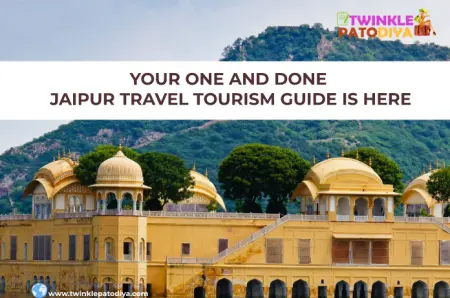The finest travel companion you could have while you plan your trip is our Jaipur travel tourism guide if you intend to visit the Pink City of Jaipur. This busy Rajasthani city is a lovely destination to spend a weekend since it oozes majesty and charm. The pink-tinged walls that tower above the city are a wonderful sight to see, and the majestic palaces bring a sense of grandeur to the contemporary metropolis. The Pink City’s beauty is enhanced by wide-open highways ornamented with lovely sculptures and tree-lined avenues. This lovely city will capture your heart and make you want to return anytime possible.
As you read through our Jaipur travel tourism guide, you will discover that there is a variety of things to see and do in Jaipur. The Jalmahal is a must-see attraction in Jaipur, as are the forts located across the city. These grim forts, which stand towering on the outskirts of Jaipur, are a legacy of Jaipur’s martial history. These forts command beautiful panoramic vistas of the enormous metropolis and its surrounds, as does the history that lies buried inside them. Taking a tour of Jaipur’s major attractions is a great opportunity to learn about the city’s history, culture, and customs.
Even though visiting Jaipur at any time of the year is delightful, experiencing it during one of the numerous local festivals will elevate your trip. The city’s hustle and bustle will provide the perfect backdrop for a memorable Jaipur holiday.
For amazing knowledge and insight on the finest Jaipur has to offer, browse through our Jaipur travel tourism guide at your pace.
1. CITY PALACE– Jaipur travel tourism guide
The City Palace Complex, which is tucked away inside the walled city, was designed and constructed by Maharaja Sawai Jai Singh II, who founded Jaipur. This spot stands first in our Jaipur travel tourism guide. The last ruling royal family still resides at the palace, which is a stunning blend of Mughal and Rajput architecture, in a secluded area. The majority of the constructions are ascribed to Maharaja Sawai Jai Singh II, but other kings also added to them. There are also displays of Maharaja Sawai Madho Singh I’s attire. Surprisingly, the Maharani’s Palace includes an intriguing collection of very well-preserved Rajput weapons, some of which date back to the 15th century. The palace is decorated with lovely ceiling murals in addition to weapons.
2. JANTAR MANTAR
The Jantar Mantar in Jaipur stands second in our Jaipur travel tourism guide, which is now a UNESCO World Heritage Site, is said to be the biggest of the five astrological observatories constructed by Maharaja Sawai Jai Singh II, the founder of Jaipur. It has sixteen geometrical instruments that can monitor celestial bodies, measure time, and watch the planets’ motions around the sun. Additionally, it houses the Interpretation Center, which enlightens visitors on the history and operating principles of the observatory.
3. HAWA MAHAL
The poet king Sawai Pratap Singh constructed the Hawa Mahal, also known as the Palace of Winds, in 1799 as a summer residence for himself and his family. This stands third in our list of Jaipur travel tourism guide. The women of the royal household may witness daily life there without being seen themselves. The outside of this unusual five-story building, which combines elements of Hindu and Islamic architecture and contains small latticed windows known as jharokhas, is meant to evoke the crown of Lord Krishna. The palace’s windows act as a type of air conditioner, circulating cold air throughout the building and making it the ideal getaway during the heat. The Hawa Mahal, a famous landmark in Jaipur made of pink sandstone, can be seen from the exterior and across the street in all its splendour.
4. JAL MAHAL
The stunning Jal Mahal or Lake Palace is one of Jaipur’s most magnificent sites. A lovely contrast can be seen between the intense blue of the sea and the pale, sand-coloured stone walls. Tourists may admire the palace’s spectacular exteriors from the heart of Man Sagar Lake, where it seems to float.
5. GAITORE (MEMORIALS OF KINGS)
The past Maharajas of Jaipur are interred in Gaitore, which is just off the Jaipur-Amber highway. This stands on no.5 in our Jaipur travel tourism guide. The chhatris (cenotaphs), which are constructed of white marble, exhibit the characteristic Rajput architectural style. The beautifully crafted pillars support the open pavilions with elaborate domes. Amid hills made of yellow sandstone stands the crematorium. A chattri’s design and magnificence are supposed to convey the power and majesty of the rulers who inhabit it. Maharaja Jai Singh’s chattri in Gaitor, which has 20 carved pillars, is the most elegant and lovely. Its elaborate sculptures are what particularly attract tourists to it.
6. The ANOKI MUSEUM OF HAND PRINTING
The Anokhi Museum of Hand Printing is about 10 minutes away by foot via Amber’s cobblestone lanes. This stands at 6th no. in our Jaipur travel tourism guide for you. The museum, which is housed in a superbly renovated haveli (mansion), features a wide array of block-printed fabrics as well as pictures, tools, and associated items, all chosen to give visitors a thorough understanding of the intricacies of this old practice.
CONCLUSION
It is accurate to state that Jaipur is the heart and soul of Indian culture. The throbbing centre of Rajasthan tourism is the chaotic yet peaceful, inviting, and hospitable Jaipur, which blends the ancient and the new.
Read more: 9 Things To Do In Jaipur At Night – Nightlife in Jaipur

